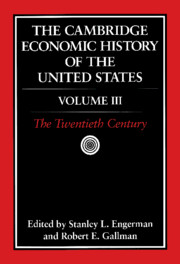Book contents
- Frontmatter
- 1 American Macroeconomic Growth in the Era of Knowledge-Based Progress: The Long-Run Perspective
- 2 Structural Changes: Regional and Urban
- 3 Twentieth-Century Canadian Economic History
- 4 The Twentieth-Century Record of Inequality and Poverty in the United States
- 5 The Great Depression
- 6 War and the American Economy in the Twentieth Century
- 7 U.S. Foreign Trade and Trade Policy in the Twentieth Century
- 8 U.S. Foreign Financial Relations in the Twentieth Century
- 9 Twentieth-Century American Population Growth
- 10 Labor Markets in the Twentieth Century
- 11 Labor Law
- 12 The Transformation of Northern Agriculture, 1910–1990
- 13 Banking and Finance in the Twentieth Century
- 14 Twentieth-Century Technological Change
- 15 The U.S. Corporate Economy in the Twentieth Century
- 16 Government Regulation of Business
- 17 The Public Sector
- Bibliographic Essays
- Index
- References
10 - Labor Markets in the Twentieth Century
Published online by Cambridge University Press: 28 March 2008
- Frontmatter
- 1 American Macroeconomic Growth in the Era of Knowledge-Based Progress: The Long-Run Perspective
- 2 Structural Changes: Regional and Urban
- 3 Twentieth-Century Canadian Economic History
- 4 The Twentieth-Century Record of Inequality and Poverty in the United States
- 5 The Great Depression
- 6 War and the American Economy in the Twentieth Century
- 7 U.S. Foreign Trade and Trade Policy in the Twentieth Century
- 8 U.S. Foreign Financial Relations in the Twentieth Century
- 9 Twentieth-Century American Population Growth
- 10 Labor Markets in the Twentieth Century
- 11 Labor Law
- 12 The Transformation of Northern Agriculture, 1910–1990
- 13 Banking and Finance in the Twentieth Century
- 14 Twentieth-Century Technological Change
- 15 The U.S. Corporate Economy in the Twentieth Century
- 16 Government Regulation of Business
- 17 The Public Sector
- Bibliographic Essays
- Index
- References
Summary
INTRODUCTION
With labor productivity and real wages lagging in the United States since the mid-1970s and inequality on the rise, many have questioned what has gone wrong. The vibrant American economy of the immediate post–World War II era appears sluggish. Labor productivity was equally sluggish during other periods, although none lasted as long as the current slowdown. The recent rise in inequality has returned the nation’s wage structure to that experienced around 1940 rather than introducing inequality of unprecedented proportions.
Most relevant to placing the current labor market in a long-run perspective is that labor gained enormously during the past hundred years. Some of the gain was reaped through real hourly wage increases and enhanced employer-provided benefits. Some came in the form of decreased hours per week and decreased years of work over the lifetime. Still other gains accrued to labor in the form of greater security in the face of unemployment, old age, sickness, and job injury. Many of these gains were obtained when labor unions were weak. That is not to say that organized labor added little to labor’s increased economic welfare over the past hundred years. Unionized labor earned between 5 and 20 percent more than nonunionized labor of equal skill during most of the period, and nonunionized labor in America may have benefited from the “voice” of unionized labor, particularly with regard to hours reductions. But there is no hard evidence that the American labor market was fundamentally transformed by unions in the same manner that European labor markets, with their institutional wage setting, employment security laws, mandated works councils, and centralization of collective bargaining, have been.
- Type
- Chapter
- Information
- The Cambridge Economic History of the United States , pp. 549 - 624Publisher: Cambridge University PressPrint publication year: 2000
References
- 43
- Cited by

